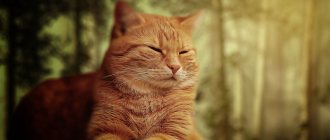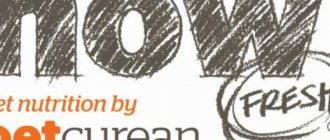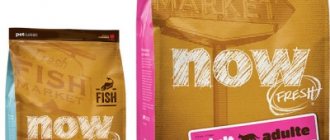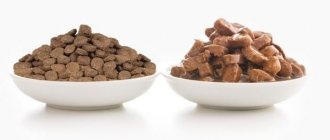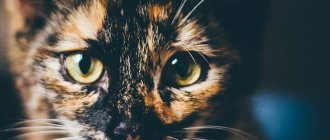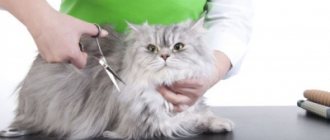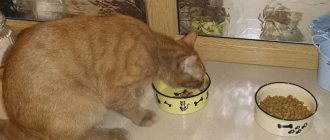If cat owners decide to switch their pets from dry to natural food, this happens most often for the following reasons:
- pet’s health problems requiring refusal of this type of feeding;
- inability to provide high-quality, expensive, premium and super-premium industrial dry products;
- the desire to diversify the menu, maintain health, prolong the life of the cat by feeding natural food, not processed with preservatives.
How to retrain correctly? How to switch a cat to homemade food, because animals are not always ready to share the owner’s intentions and desperately resist innovation, refusing the new diet? Often such voluntary fasting continues for a long time. The cat does not eat, at best it can sniff the food, as a result it loses weight, disturbances in its general condition and behavior appear, and its appearance changes.
Why is it so difficult to wean a cat off ready-made food?
The composition of dry food, especially the line of economy class products, includes a large number of attractants and additives - special ingredients designed to attract the animal, enhance the taste and smell of food, causing persistent addiction to such food. These components are mixed into all feed without exception, especially in super-economy class products. Cats almost immediately become addicted to drugs by eating such food.
The absence of useful components is hidden by manufacturers through the introduction of such chemicals. They significantly worsen the condition of the teeth and fur of pets, cause damage to the psyche, and cause serious illnesses and allergic reactions.
The dangers of dry food
Often the true composition of a product is hidden by the manufacturer. Poor quality food often causes many side effects:
- poisoning with chemicals: dyes and flavors;
- the development of urolithiasis due to an excess of salts as preservatives, especially dangerous for neutered cats;
- the occurrence of vitamin deficiency due to the lack of necessary vitamins and microelements;
- heart failure, allergic reactions;
- Dysbacteriosis is the death of beneficial intestinal microflora, manifested by indigestion, metabolic disorders, skin and coat problems.
Prolonged fasting leads to lipidosis (fatty degeneration) of the liver
This is a common liver disease in cats, characterized by infiltration of hepatocytes (liver cells) with triglycerides and neutral fats, leading to bile stagnation (cholestasis) and permanent liver dysfunction. Liver lipidosis is one of the most common lesions of the liver tissue in cats; the disease clinically develops when more than 80% of hepatocytes are affected; the death of the animal can be avoided only with well-organized and timely treatment.
Source
Transferring the cat to homemade food
You can continue to feed the animal its usual food, gradually mixing in various ingredients of another product until a complete replacement occurs. The new type of food should be given to the animal in small quantities in small pieces, no different in size from normal everyday food. After 4-5 days, the volume of dry food is reduced to 50%, then the replacement occurs completely within 10-15 days.
If the pet prefers certain products in addition to dry food, temporarily limit them only to them until the cat is completely weaned from “drying”.
If it is difficult to determine your pet’s taste preferences, it is worth offering several different dishes, placing them in different bowls. The cat will choose and take a liking to the new food, then the cat will be completely switched to homemade food.
There is an option when the volume of regular food is reduced, and the animal, without being completely full, is saturated with another product, homemade, located close to the main, regular food.
Usually, a cat’s refusal of new food plunges the owners into panic - they worry that the pet will become exhausted, get sick, or die. But the animal will not die of hunger if there is food nearby, even if it is tasteless and unloved. Fears are unfounded, remember that you are acting for the benefit of your pet, the cat will humble itself and accept your conditions.
Can kittens eat raw meat?
When can a kitten be given meat? Babies up to 1 month of age feed on mother's milk if she is alive and healthy. At about 1 month, complementary foods are introduced. This must be raw meat, frozen for at least 3 days, served either as minced meat or in the form of small pieces. If kittens can cope with pieces, then this option is better.
It is preferable to give raw meat to kittens over dry and wet food, even if you are then going to feed them factory-made food. Meat adjusts the functioning of the predator’s digestive tract in the right way.
Advice from felinologists
Is it possible to quickly switch a cat to natural food, cat lovers will tell you:
- the addition of catnip facilitates faster adaptation to new food; over time, the supply is stopped, the animal gradually gets used to the food;
- several pieces of dry food are placed on the meat to give it a familiar smell, deceiving the cat;
- probiotics are useful during transition - feeding with dry food worsens peristalsis, lactobacilli improve the digestion process, the microflora is renewed, adaptation is easier;
- during the transition to natural food, vitamins are recommended;
- the bowl of food is removed after 15-20 minutes, regardless of whether there is food left in it or not.
Transition process
We always start with one type of meat. This does not depend on whether the cat immediately switches to raw, or whether he is transferred in stages through baked and boiled. We introduce one type of meat once a week and watch the reaction. If there is no allergic reaction (it can manifest itself in the form of vomiting, scratching, hair loss, etc.), then the product is suitable. If a negative reaction is observed, we cancel the product and do not use it again.
New products can be introduced to kittens more often: once every 3-4 days, because their metabolic processes proceed better - and allergies, if any, will become noticeable earlier.
While the cat does not know how to eat meat, we cut it finely. Then, when the meat becomes a familiar product, it can be served in large pieces so that the cat can tear off as much as necessary and thereby develop the jaw muscles, and also realize the predatory instinct.
However, when switching to a non-raw diet after feeding, problems may arise. The digestive system of cats that consume food works somewhat differently. Firstly, the concentration of gastric juice is lower, because high acidity is not needed for feed processing. Secondly, other digestive enzymes work. Thirdly, the food is not whole pieces of meat, but an already ground mixture. Accordingly, more effort is needed to digest meat. All this can cause unexpected reactions during the transition period until the digestive system is rebuilt.
All these ingredients fit into small dry pads
Cat vomits meat
This may indicate intolerance to the product. In this case, it is better to refuse this type of meat. However, if the pieces were too large or the cat overate, vomiting may mean that the meat needs to be cut smaller at first and not given so much.
Anticipating the question about infections, let's say that situations where a cat gets sick from raw meat are rare and are associated with the fact that he was offered a low-quality product from a spontaneous market, from private sellers or hunters, or not frozen. If your cat eats low-quality meat, she is at risk for gastrointestinal infections.
Article continues after advertisement
The cat has diarrhea after eating meat
In some cases, when the digestive system cannot cope with a meat product, because... After feeding, it does not work at full capacity, and diarrhea and indigestion may occur. Again, it is recommended to reduce the portions and cut the pieces smaller.
Also, in case of such problems, it is recommended to first boil or bake the meat to make it easier to digest. But this is a temporary measure, which should be abandoned later, when digestion returns to normal.
The cat has gas
Flatulence can become a constant companion for a cat during the transition period. More often this happens not so much from a meat diet, but from a mixed diet, while the food has not yet been stopped. A couple of weeks after eliminating the factory food from the menu, everything should return to normal. But if a month has passed since the cat was on the natural diet, and gases are still terrorizing the whole family, it is worth consulting with a veterinarian.
The cat is allergic to meat
Allergy to all types of meat is excluded. Cats are not vegetarians. If a cat does not eat meat, but prefers only plant foods, this indicates a pathology of the gastrointestinal tract - such cats do not live long. An urgent examination of the body is needed!
When owners think that a cat has an allergy, it may, in fact, simply be a reaction during a transition period, because... the digestive system cannot cope with the new product. If it looks like an allergy (for example, the cat began to itch, areas of baldness appeared, etc. symptoms), then, firstly, it is worth thinking about whether this allergy could have arisen from something else (not necessarily food) . Secondly, it may be a symptom of a non-meat-related infection. Thirdly, if it is still an allergy to meat, simply exclude this type of meat from your diet.
Most often, allergies manifest themselves to chicken products, because... At poultry farms, chickens are shamelessly stuffed with chemicals. Therefore, chicken is the first product to suspect. But this does not mean that a cat cannot be allergic, for example, to turkey or beef. It is worth gradually eliminating various foods from the diet and thus identifying the allergen. But always start testing with chicken.
Home feeding diet
The main product in this type of diet is meat, about 80%. The rest is cereals, vitamins, vegetable supplements. Natural feeding requires an accurate calculation of the daily food intake; the idea that the cat itself knows how much it needs to eat is wrong. Often, fluffy beauties, without knowing the limits, gobbling up delicious foods on both cheeks, acquire excess weight, heart and respiratory problems. Different ages are taken into account when compiling the daily menu.
How to calculate a kitten's nutritional intake
Two and a half months is the age at which a baby can be separated from its mother. Before nine months, the kitten should receive no more than 10% of its weight in food. With a weight of 2000 g, the weight of the daily portion is 200 g. 50% is meat food, 50% is fish products.
How to calculate the amount of food per day for an adult cat
An adult animal needs only 5% of its weight in feed. With an animal weighing 5 kg - 250 g of natural food, consisting of equal parts of fermented milk and meat products. 20 g of vegetables and a few drops of vegetable oil are allowed. Active pets, who expend a lot of energy, are given more food, inactive, obese, and elderly pets require less.
What can you give your cat?
The main components of natural cat food are:
- fish is a favorite product of fluffy beauties; marine varieties are recommended, both raw and boiled. Boiled fish should be cleaned of bones; they can be easily separated from the pulp; they can be swallowed unchewed or get stuck in the esophagus;
- meat - lean chicken, beef, lamb, rabbit, horse meat, scalded with boiling water, are allowed. Pork is banned;
- by-products - liver, lungs, heart, kidneys - are introduced into the diet 2 times a week - their nutritional value and usefulness are low. If there are signs of poor digestion: vomiting, diarrhea, by-products are excluded from the animal’s menu;
- fermented milk products - kefir, cottage cheese, medium-fat starters. Low-fat foods cause stool upset. Cats do not tolerate milk well - the number of enzymes that break down lactose decreases with age;
- vegetables - any are allowed: cabbage, carrots, peppers, pumpkin. A combination is possible. They are given in crushed raw form and can be mixed with meat. Potatoes - excluded;
- eggs - chicken or quail are suitable. The yolk and white are mixed. Serve separately or with kefir and cottage cheese.
A pet’s illness or surgery is a reason to contact a veterinarian to correct the animal’s nutrition.
Chicken necks have proven themselves well for natural feeding of cats. They are prepared as follows: mince twice through a meat grinder to grind hard bones, add a little boiled rice or buckwheat, and grated carrots. They mix.
Natural food is natural healthy nutrition for your feline. With good care, a kind attitude, a positive attitude of the owners, and a well-designed feeding diet, the animal will be healthy, happy, and will live a long, fulfilling life next to its owners.
What “surprises” may lie in wait for you?
The transition to natural raw food occurs differently for different dogs. The age and health status of the pet plays an important role in this. The older the animal, the more difficult it is for its body to accept a new feeding scheme. Such animals need more time to get used to and learn to assimilate foods “unknown” to the body.
So, what can change when switching your pet to a raw diet?
Detoxification
The transition from commercial food to natural raw food causes the body's need to remove waste and toxins. Excretion occurs through the intestines, skin and glands.
Depending on your health condition, the detoxification period may last one or several weeks and be accompanied by the following symptoms:
- Nausea.
- Diarrhea.
- Hair loss.
- Dermatitis and dry skin.
- Copious discharge of earwax.
- Discharge from the eyes.
If one or more signs appear, you should not immediately panic and think that the dog is sick. In fact, these are the first signs that the body is getting rid of harmful toxic substances, the ears and anal glands are being cleansed. A little time will pass and you will see noticeable changes for the better: shiny coat, firm muscles and elasticity of the skin, good appetite and excellent physical activity.
Changing the stool
After switching the dog to a natural raw diet, there will, of course, be a change in the quality of the stool. Since natural food contains more high-quality and useful microelements, they are perfectly absorbed by the body, leaving a much smaller pile volume at the output than you are used to seeing with dry feeding.
The quality of the stool will directly depend on what your pet ate. Don’t be alarmed if you find pieces of undigested carrots in your poop, for example!
The color of the stool may also vary in color and consistency. If the dog has eaten more bone products or cottage cheese, the stool will be light, almost white. But excessive consumption of offal can cause disorder.
It should be remembered: if diarrhea lasts for a long time, this is a reason to consult a veterinarian. However, you should also not confuse diarrhea with “soft” stools. Over time, you will learn to control the process of combining products, and the stool will become “uniform”.
Reduced water consumption
Don't be alarmed if your dog drinks less water when switching to a natural diet. The fact is that the pet begins to eat fresh, moisture-filled foods. Barbos may not go near a bowl of water for several days. But this does not mean that it should be removed. Fresh, clean water should always be freely available and in sufficient quantity.
